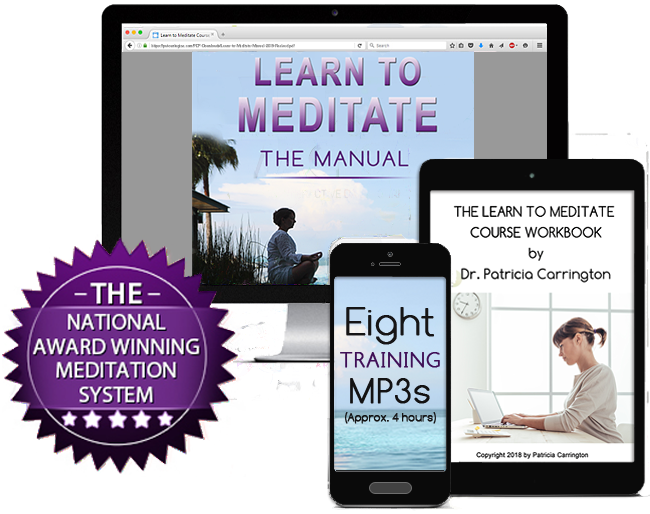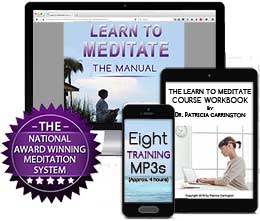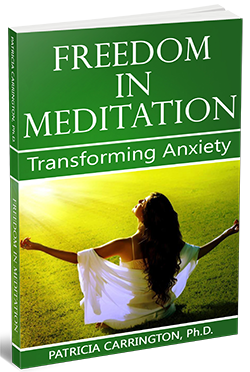Meditation and Personal Growth
Patricia Carrington, Ph.D.
Author of “The Book of Meditation”
As we have indicated, the contribution of meditation to personal growth does not stop with removing symptoms, even such crippling symptoms as the repression of crucial memories or an inability to come to terms with anger in oneself, but reaches further, effecting a change which has to do with the unfolding of a sense of personal worth, a growing awareness of one’s true self. A meditator expresses this in his journal:
When I meditate I go into myself. I come into myself. I apprehend myself as an entity separate from every other entity, separate from every other thing. I am not my house, nor my car, nor the clothes I wear. I am not the rules I live by, nor even the words I speak. I am me. How strange! This is what it feels like to be me! 1
The ability to view ourselves as separate from our surroundings is called field independence by psychologists. This capacity frequently increases with meditation, an important consideration since people who are ‘field independent’ are apt to see themselves more distinctly, more clearly, and in a more sharply detailed fashion. They tend to be inner-directed rather than outer-directed, asking themselves, ‘How does this feel to me?’ rather than, ‘How does this look to others?’ Those with a less developed sense of identity, who tend to rely on other people to shape their attitudes and judgments, are known as ‘field dependent’.
These aspects of personality are particularly interesting because they have some highly reliable testing instruments available to measure them. One is the Embedded Figures Test, a refined version of those puzzles given to children where they are asked to find the ‘little pictures’ hidden within the larger picture. The more ‘field independent’ a person is, the more rapidly he can isolate the little figures from the big one that embraces them.
In the Rod and Frame Test, the person has to perform a physical task: straighten a rod viewed in a somewhat tilted frame. People who are more ‘field dependent’ tend to straighten the rod by aligning it so that it is parallel with the vertical edges of the frame; they use outer cues when performing their straightening task. Those who are more ‘field independent’ tend to straighten the rod by aligning it with the vertical of their own body; they use their own self as the reference point. The Embedded Figures and Rod and Frame Tests are considered very ‘stable’ measures; the way a person approaches these tasks tends not to change over time once she has reached adulthood. It is all the more interesting, therefore, to discover that these tests often show positive changes in people who have been meditating. In a study conducted with Zazen meditators, for example, researcher Melissa Hines found that her subjects scored significantly higher on the Embedded Figures Test after they had been meditating for ten weeks than they had before learning to meditate.2
When psychologist William Linden taught a group of third grade children from an underprivileged background a form of Zazen meditation, he found much the same thing.3 These children were tested with the Embedded Figures Test before they started meditating and again after a period of thirteen weeks during which they had practiced meditation in school for a few minutes each day. At the end of the experiment, their scores showed that they were significantly more ‘field independent’ – a finding of importance to people who are concerned with fostering individuality and independence in young children.
The results using the Rod and Frame Test are impressive because no matter how often a person performs this task, his score will not improve with practice. Using the Rod and Frame Test, the Embedded Figures Test and a task which measures the tendency to perceive the apparent movement of a spot of light in a darkened room, psychologist Kenneth Pelletier of the University of California School of Medicine tested a group of subjects before they learned TM and again after they had been practicing it for three months.4 He compared them with control subjects over that same time interval. At the end of this period, the meditators’ scores had improved significantly on all three measures, while those of the non-meditators had not improved at all. Basic perceptual measures such as the Rod and Frame Test and the Embedded Figures Test had therefore changed with meditation.
In a study done at Princeton University, researcher David James later showed that field independence, as measured by the Embedded Figures Test, can even change over the short term if a person meditates during the interval between testing. A group of subjects improved significantly more on scores of field independence after twenty minutes of meditating than another group of subjects who simply rested for twenty minutes.5 In fact, the scores of the ‘resters’ remained unchanged over this interval. This finding is surprising since it had previously been thought that field independence could not fluctuate on a short term basis. It suggests a strong immediate influence of meditation on our interaction with the environment.
The findings on meditation and field independence may have important practical implications when we consider the desirability of field independence for certain types of work. The practice of meditation has, for example, been shown to enhance field independence in art students from two universities, 6 a result which may explain some of the increased creativity frequently reported in meditators. This is a subject we will look at more closely when we come to discuss the relationship between meditation and creativity.
The increased field independence seen in mediators may also be related to the interesting fact that meditators often report that they have developed a greater sense of their own identity since they have been meditating. They tend to sense their personal rights in situations where formerly they might have been unaware of them, or can now withstand social pressures without abandoning their own opinions. They may also find themselves becoming more decisive and expressing ideas more openly.
A patient of mine, Richard O., is a successful professional man who grew up in a home where the family members tended to deny their emotions. They rarely showed anger or sadness, always acting ‘reasonably’. Richard learned to exert a tight control over his own emotions and eventually almost lost awareness of them. Now, more often than not, he could not tell when he was angry or when he was sad, or identify any other strong feeling. He could only reason that maybe he might have felt a particular way. One of the few times when genuine feelings were available to him was when he had had some drinks, and drinking was becoming a problem for him. One of the first tasks of psychotherapy was to help Richard get in touch with his own feelings and, among other therapeutic approaches; I suggested that he learn Clinically Standardized Meditation (CSM).
On emerging from his initial meditation, Richard said he had felt as though he were ‘in another world’ and would have liked to have stayed there for a long time; in fact, indefinitely. When he phoned me the following day to report on his meditation (a routine procedure) he asked me if he might be allowed to meditate more than twice a day, because he found it such a ‘pleasant experience’. I suggested that he not increase his meditation time because this might release tensions too fast for him to handle comfortably.
After meditating for one week, Richard returned for his psychotherapy session already showing changes. He no longer compulsively interrupted his sessions to go outside and grab a cigarette (and never again had to interrupt a therapy session to smoke), he was more relaxed in his posture, and he now talked about different subjects. Before he had been businesslike and intellectual, speaking in a highly organized fashion about his relationship with his wife. In this session, he talked about himself in a somewhat musing fashion, bringing up thoughts about his childhood and his own inability to enjoy himself or to ‘play’ in life. He seemed to have a new interest in exploring his own reactions and for the first time expressed a desire to use therapy to enrich his own life rather than just as a tool to improve his marriage.
The following week, while traveling on a plane, he was meditating and had the impression that he heard his own voice saying, ‘Empty yourself of your desires!’ This rather mysterious statement was followed by an experience of exaltation and the further words: ‘I can have a drink or smoke a cigarette if I want to – but I don’t have to.’ This seemed to him to be a startling revelation, giving him for the first time a feeling that he now had a choice of whether or not to drink.
Richard had always found it extremely difficult to know what his own wishes were. After meditating for about three weeks, he reported an ‘unusual incident’. His children had asked him to stop at a roadside stand to buy ice cream. His usual response to such a request would have been to buy the same ice cream for himself as for the others, not realizing that he, too, might have preference for a particular flavor. This time, however, he found himself saying, ‘Fine, I’ll get you what you want – then I’m going to get chocolate ice cream for myself.’ Seemingly a small thing, this was important: he had sensed his own need and stayed with it. The experience of a new and convincing sense of self during meditation often forms a base of self-awareness which can be built upon to advantage in psychotherapy. Archimedes, the ancient Greek mathematician and physicist, is reputed to have said: ‘Give me a place to stand and I will move the world.’ Certain patients seem unable to move ahead in therapy because they appear to lack a base of self on which to stand in order to produce change. In these cases even deep psychological insights may build on quicksand, as it were. Meditation often makes an important contribution to therapy by building into the person a new, deeply convincing, but largely wordless experience of self.
Another meditator illustrates this process. Jack was an intelligent although extremely withdrawn man who had been in psychotherapy of one sort or another for nineteen years. Being meticulous in his habits and extremely responsible, he was able to hold onto various administrative positions for a long period of time, but at home he led the life of a recluse with few friends or relationships. Although he was in his mid-forties he had had virtually no sex life. Jack’s relationships were fantasy ones. His life was filled with daydreams of dating attractive women but these were always followed by obsessive worries about how he might, even timidly, approach such women should he meet them.
At his therapists’ suggestions, he had attended marathons, encounter groups, group therapy, and even undergone a full course of ‘systematic desensitization’ by a behavior therapist – all to no avail. The behavior therapy had even made his symptoms worse because as he tried to imagine dating in the context of being deeply relaxed, instead of feeling calmer he became more anxious and developed palpitations. His increasing tension made him abandon this form of therapy.
His present therapist suggested to him, almost as a last resort, that he learn CSM. Jack, who usually returned sneering after having tried out some new method that had been suggested to him, agreed to learn it.
Surprisingly, meditation worked. Jack was enthusiastic about it, and according to both him and his therapist, it ‘remade’ this man’s life in many ways. He was deeply impressed with the technique from the beginning and became a regular meditator. After beginning meditation, his attitude toward experimenting with relationships changed markedly. He was soon able to try out new forms of relating to others. He initiated some tentative sexual relationships, and his progress along these lines continued.
For years people had been making constructive suggestions to Jack about things he might do to ‘change his life-style’. Some of these suggestions had been daring, some mild; but he had not been able to act on even the simplest of them. As he put it, ‘Even though I could recognize that their advice was good, there was nobody present in me that could respond to it – now there is a me to listen, and respond, and move on these things. Meditation has given me a center to myself.’
The ‘center’ which Jack refers to seems to be an ‘inner ear’ that is sensitive to his own being. It is a center of the self that can mobilize and begin to take action. The result is that where before he seemed to have no ‘backbone’ or substance, now he had a new assertiveness and for the first time was able to make progress in his psychotherapy.
Through meditation, people begin to see themselves as self determining beings, separate from their surroundings. At the same time they also begin to feel more intimately connected with all that surrounds them. An entry in my late husband’s meditation journal expresses this:
During meditation I am me, not ‘you’, not your values. I am me, and my values are reconstituting me. . . . A tree is not a slave, its growth is its own. In meditation I grow as a tree, I live with the sun and the earth, and am my own ten commandments. . . .
Learn about Clinically Standardized Meditation
A Gentle, Easy-to-Learn, Form of Meditation
Clinically Standardized Meditation (CSM) is a clinically sensitive meditation method used by numerous medical institutions, organizations, and individuals worldwide.
- Meditation journal of George Edington (personal communication).
- M. Hines, ‘Meditation and Creativity: A Pilot Study’ (senior Thesis, Princeton University, 1970).
- W. Linden, ‘Practicing of Meditation by School Children and Their Levels of Field Dependence-Independence, Test Anxiety, and Reading Achievement’, Journal of Consulting and Clinical Psychology, 41 (1973), pp. 139–43.
- K. R. Pelletier, ‘The Effects of the Transcendental Meditation Program on Perceptual Style: Increased Field Independence’, in Orme-Johnson and Farrow, (ed.), op. cit., vol. I, pp. 337–45.
- D. James, ‘The Short-Term Effects of Transcendental Meditation on Field Independence: A Pilot Study’ (unpublished paper, Princeton University, 1976).
- L. C. Fergusson, ‘Field Independence and Art Achievement in Meditating and Non meditating College Students’, Perceptual and Motor Skills, 75 (1992), pp. 1171–5.








